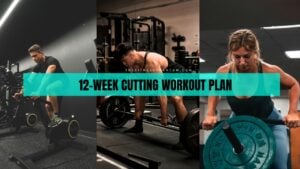Calves are small but crucial muscles of the leg. They are involved in various acitivies that we do throughout the day, including walking, stepping on the stairs, running, hopping, and squatting.
However, people often forget to train these muscles specifically and leave them undeveloped.
But if you want to grow your calves and sculpt your legs, you should always include calf workouts in your training regime, whether you want to build muscle or shed fat.
To bolster your lower legs, you don’t need machines or fancy gym equipment. You can even do that with dumbbells, and you’ll see how in this article.
Things you’ll learn below:
- The Anatomy and Functions of Calf Muscles
- Benefits of Training Calves
- Can You Grow Your Calves with Dumbbells Only?
- The 8 Best Dumbbell Calf Exercises
- The Fitness Phantom Tips to Get Bigger Calves
The Anatomy and Functions of Calf Muscles

Calves are small muscles located on the rear side of your legs below your knee joint. They are made up of two main muscle groups: gastrocnemius (which lies on top) and soleus (which lies underneath).
The Gastrocnemius muscle group is the largest of the two main muscles that make up your calf. It’s also one of the most important and responsible for helping you to lift your toes and push off with your foot when you walk or run.
The soleus is a long muscle that runs along the outside part of your calf, from the heel to just below your knee. It is responsible for helping you walk and run efficiently by controlling foot movement, stabilizing joints, and moving your leg forward while supporting it at the same time.
The Achilles tendon is another muscle that connects the calf muscles to the heel bone. It is sturdy and has many stretchy muscle fibers that allow you to bend at the ankle when you jump or run.
You can solidify all these muscles with the help of different calf raise variations.
Benefits of Training Calves Muscles
The calves are the crucial leg muscles that play a role in walking, running, and performing various exercises, such as squats, deadlifts, and higher jumps, by providing power and strength to our legs.
Here are some key reasons for training calves:
- The calves muscles provides the stability to the entire leg. They help in bending and straightening your legs, as well as keeping them stable when you walk or run. When these muscles are underdeveloped, it can lead to a lot of other problems like pain during exercise and even arthritis later on in life. So it’s best to keep them strong and healthy by training them frequently.
- The calves are involved in almost every leg exercise you do, such as squats, lunges, and step-ups. So, having solid calves provides stability to the other muscles of your legs, such as the hamstrings and quads, and reduces stress on the Achilles tendon.1 Masood T, Kalliokoski K, Magnusson SP, Bojsen-Moller J, Finni T. Effects of 12-wk eccentric calf muscle training on muscle-tendon glucose uptake and SEMG in patients with chronic Achilles tendon pain. J App Physiol. 2014;117(2):105-11. doi:10.1152/japplphysiol.00113.2014, and enhance your performance.
- If you’re an athlete, stronger calves will help you run and jump efficiently and maximize your performance.
Can You Grow Your Calves with Dumbbells Only?

Yes, the dumbbells provide enough resistance and variation to help you grow your calves bigger.2 Kassiano, Witalo & Costa, Daniella & Kunevaliki, Gabriel & Lisboa, Felipe & Tricoli, Ian & Francsuel, Jarlisson & Alves, Luis & Gomes de Lima Stavinski, Natã & Cyrino, Edilson. (2024). Bigger calves from doing higher resistance training volume? International Journal of Sports Medicine. 10.1055/a-2316-7885.
Dumbbells are moveable, easy to carry, and a small piece of equipment that allows you to train your calves in several ways.
For example, with dumbbells, you can hammer your calves both in the standing and seated positions and with unilateral and bilateral exercises, ensuring your calves are trained from every angle.
8 Best Dumbbell Calf Exercises to Build Mass
- Dumbbell One-Leg Leaning Calf Raise
- Alternate Dumbbell Standing Calf Raises
- Seated Dumbbell Calf Raises
- Bent-over Sumo Stance Calf Raises
- Farmers Walk on Toes
- Half Kneeling Single Leg Calf Raises
- Squatted Calf Raises
- Heels Lifted Squat
1. Dumbbell One-Leg Leaning Calf Raise
- Holding a dumbbell in your right hand, stand against the wall.
- Lean your body forward and place your left hand on the wall.
- Lift your left foot off the floor and bend your knee. That’s the start.
- Raise your heel as high as possible and slowly lower it until you feel pain in your calf muscle.
The one-leg leaning dumbbell calf raise is a unilateral exercise. It allows you to focus on one leg at a time and helps build proportional calves.
TFP Recommended Sets and Reps: 4 x 15 reps on each side.
2. Single-leg Standing Calf Raises
- Place a stepper on the floor against the wall.
- Grab a dumbbell in your right hand and stand on your right foot on the stepper.
- Slightly lean forward and place your left hand on the wall.
- Raise your heel as high as possible, pause for a second, and then slowly lower it down.
The standing dumbbell calf raise strengthens and tones calves as well as improves the balance and stability of the ankle joint.
It requires keeping your torso slightly lean and standing on a stepper, which makes it slightly different from the first exercise (leaning calf raise).
TFP Recommended Sets and Reps: 4 x 15 reps on each side. Alternate with the first exercise.
3. Seated Dumbbell Calf Raises
- Holding one dumbbell in each hand, sit on the edge of a flat bench.
- Bend your knees 90 degrees and place the balls of your feet on the stepper with your heels hanging off.
- Keep the dumbbells on your knees and keep your torso upright.
- Lift your heels as high as possible, squeeze your calves at the top, and then lower them down.
By sitting down and bending your knee, the seated heels decrease the work of the gastrocnemius muscle and engage more of the soleus muscle.
Performing the combination of standing and seated heels raises helps you achieve strong and aesthetic calves.
TFP Recommended Sets and Reps: 3 x 15 reps. Perform single-leg seated calf raises to work on each leg separately and improve symmetry.
4. Bent-over Sumo Stance Calf Raises
- Holding a pair of dumbbells, stand in the sumo squat position, feet two times wider than your hip-width and toes pointing slightly out.
- Bend your torso forward and hold your arms straight below your chest, dumbbells touching the floor, and maintain a flat back. This will be your starting position.
- Raise your heels and torso simultaneously until your calves are fully contracted.
- Pause for a moment at the top and slowly return your heels to the floor.
The sumo stance calf raises are a great way to target the calves and build strength in your legs, including the glutes.
It targets your calves from a different angle and helps increase strength and mobility. You can do it alternatively with other dumbbell calf exercises to achieve the best results.
TFP Recommended Sets and Reps: Aim for three sets of 20 reps, each set with moderate-weight dumbbells. Substitute this exercise with a squatted calf raise.
5. Farmers Walk on Toes
- Holding one dumbbell in each hand, stand upright with your feet together.
- Walk out as far as you can on your tip toes and then return to complete one round.
- Do it until you feel the pain in your gastrocnemius muscles.
The farmer’s walk is a great exercise for strengthening the legs, including your calves.
It is especially effective when you walk on your tip toes instead of your entire feet. It also helps you develop balance and coordination and burn decent calories quickly.
TFP Recommended Sets and Reps: I suggest using this exercise as a warm-up to increase the blood flow before you start the main exercises on your leg day. Walk 20 steps three times.
6. Half Kneeling Single Leg Calf Raises
- Sit on your right knee with your left foot on the ground and knees 75-90 degrees bent, ensuring your left knee is just above your fingers.
- Grab a dumbbell and put it on the edge of your thigh.
- Sit straight with a tight core and lift your heels as high as possible.
- Feel the stretch for two seconds, then return to the start.
The half-kneeling calf raise helps you train your lower legs, especially the soleus muscles, without a foot platform or stepper.
Besides calves, it also improves ankle stability and helps achieve better lower leg health.
You can alternate or substitute half-kneeling calf raises with seated ones (exercise #3), as they both work the same muscles.
TFP Recommended Sets and Reps: 3 sets x 15 reps on each side. I also suggest doing more on your weaker leg to even out lopsidedness.
7. Squatted Calf Raises
- Position a stepper on the floor against a bench or firm object that can provide support during the movement.
- Grab a dumbbell and sit on the balls of your feet, your heels hanging off, and your balls on the stepper.
- Hold the dumbbell as you like and grasp the bench for support. That’s the start.
- Pushing the balls of your feet down, lift your heels until your calves are fully engaged.
- Pause for two seconds, feel the squeeze, then return to the start and repeat.
The squatted calf raises is a kind of compound movement that involves isotonic and isometric movements.
Staying in a seated position keeps your quads and glutes engaged, and lifting your heels bolsters your calves throughout the exercise, promoting better lower body fitness.
TFP Recommended Sets and Reps: 4 sets x 15 reps. Use your arms alternatively to hold the dumbbell.
8. Heels Lifted Squat
- Grab one dumbbell in each with a neutral grip and stand straight with your feet together.
- Slightly lean forward and lift your heels off the ground till your calves are activated.
- Perform as many squats as possible. Your knees will cross your toes, so make sure you use light dumbbells to avoid putting excess stress on your joints.
The heels-lifted squat or toe squat not only strengthens quads, glutes, and calves but also enhances balance, ankle stability, and functional fitness, and that too without additional equipment.
TFP Recommended Sets and Reps: 3 sets x 10-12 reps. You can use heavy dumbbells to put more stress on your calves and build them bigger.
The Fitness Phantom Tips to Get Bigger Calves
When it comes to performing calf raises effectively, I recommend keeping three things in mind: foot positions, intensity, and frequency.
During the calf raises, you can use three different foot positions to hit your calves: foot pointed outward, foot pointed inward, and foot pointed forward.
A study has shown that doing calf raises with your feet pointed outward increases the muscle thickness of the medial gastrocnemius, while performing calf raises in an inward feet stance provides greater gains for the lateral gastrocnemius head in nine weeks of training.3 Different Foot Positioning During Calf Training to Induce Portion-Specific Gastrocnemius Muscle Hypertrophy, 2020 Aug – Journal of Strength Conditioning Research
So, it would be best to perform calf raises with different foot positions to achieve the maximum results.
The second tip for growing calves is intensity or speed. Calf raises that are done deliberately with decent stretch and contraction yield slightly better results than those that are done rapidly.4 Gavanda, Simon et al. “Low-intensity blood flow restriction calf muscle training leads to similar functional and structural adaptations than conventional low-load strength training: A randomized controlled trial.” PloS one vol. 15,6 e0235377. 30 Jun. 2020, doi:10.1371/journal.pone.0235377 So, make sure you focus on contracting your calves during each rep for maximum growth.
The last thing is the frequency of your calf workouts. The weaker the calves, the higher the frequency. For example, if your calves are strong, training once a week would be enough, but if your calves are underdeveloped, I recommend hitting them three times weekly.
It doesn’t matter how many times you train your lower legs; make sure to alternate the different variations of calf raises to get the best results.
References
- 1Masood T, Kalliokoski K, Magnusson SP, Bojsen-Moller J, Finni T. Effects of 12-wk eccentric calf muscle training on muscle-tendon glucose uptake and SEMG in patients with chronic Achilles tendon pain. J App Physiol. 2014;117(2):105-11. doi:10.1152/japplphysiol.00113.2014
- 2Kassiano, Witalo & Costa, Daniella & Kunevaliki, Gabriel & Lisboa, Felipe & Tricoli, Ian & Francsuel, Jarlisson & Alves, Luis & Gomes de Lima Stavinski, Natã & Cyrino, Edilson. (2024). Bigger calves from doing higher resistance training volume? International Journal of Sports Medicine. 10.1055/a-2316-7885.
- 3Different Foot Positioning During Calf Training to Induce Portion-Specific Gastrocnemius Muscle Hypertrophy, 2020 Aug – Journal of Strength Conditioning Research
- 4Gavanda, Simon et al. “Low-intensity blood flow restriction calf muscle training leads to similar functional and structural adaptations than conventional low-load strength training: A randomized controlled trial.” PloS one vol. 15,6 e0235377. 30 Jun. 2020, doi:10.1371/journal.pone.0235377






